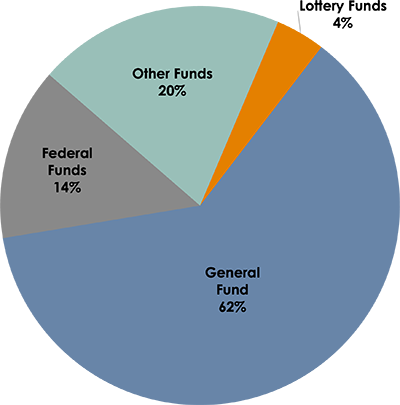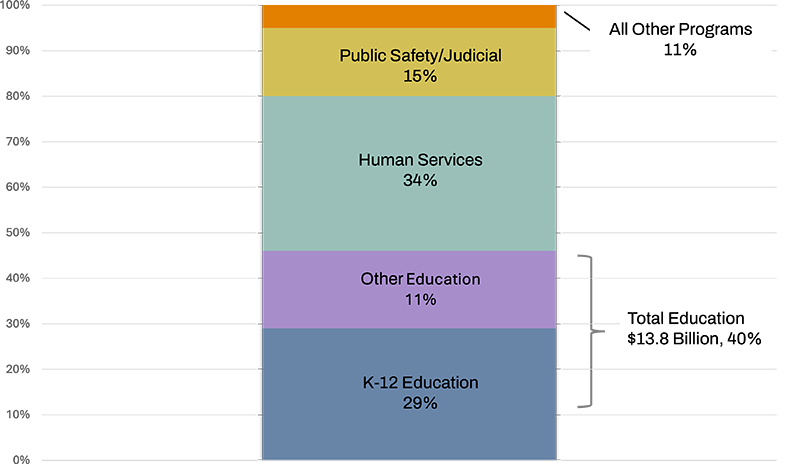 Wallowa High School in Wallowa. (Oregon State Archives Scenic Images Collection)
Wallowa High School in Wallowa. (Oregon State Archives Scenic Images Collection)
Important Links
Overview
Oregon has 197 public school districts that operate a total of 1,273 public schools. For the 2023-24 school year, the teaching staff working in Oregon’s public schools numbered the equivalent of 31,598 full-time positions. The average student/teacher ratio for the 2023-24 school year in Oregon was 17.3.
Public schools enrolled 547,424 students from kindergarten through grade 12 (as of Oct. 1, 2023), of which
- 41% of students were students of color (national average: 55.7%);
- 16% of students were in Special Education (national average: 15%);
- 33.1% of Oregon students were experiencing poverty (meaning students experiencing any of the following at any time in the school year: receiving TANF or SNAP, are in foster care, are migrant, and/or are houseless);
- 18.8% of students were English Language Learners (national average: 9.4%).
- Oregon’s combined state and local share of the K-12 education budget was $9.92 billion for the school year ending June 30, 2024.

2023-25 Legislatively Approved K-12 Funding by Source
Source: Legislative Fiscal Office Sources
Oregon Department of Education, Oregon Statewide Report Card, 2023-24; U.S. Department of Education, National Center for Education Statistics, 2022-23.
State Board of Education
The board provides leadership and vision for Oregon’s public schools and districts by enacting equitable policies and promoting educational practices that lead directly to the success of every student in education and in life. The board sets policies and standards for Oregon’s public school districts and educational service districts. The board is also responsible for adopting administrative rules that the Oregon Department of Education implements.
The board has nine voting members appointed by the Governor and confirmed by the Senate. Members are appointed to represent Oregon’s congressional districts, and three members represent the state at large. One at-large member must be engaged in teaching as a licensed teacher, and one must be engaged as a classified staff member in a public school or education service district. Members are limited to two consecutive terms.
Board members are Jennifer Scurlock, Chair (2027); Shimiko Montgomery, Vice-Chair (2026); Julie Bettles (2026), Libra Forde (2028), Mona Khalil (2028), Cynthia Richardson (2027); Vicky López Sánchez (2027); Bridgett Wheeler (2028); and Sarah Wofford (2028).
Department of Education
The Governor acts as the superintendent of schools. The Governor has authority to appoint a deputy superintendent of public instruction to run the Oregon Department of Education.
ODE oversees Oregon’s public K–12 education system and encompasses the Youth Development Division, Oregon School for the Deaf and other programs. For more information, see
ODE’s entry in the Executive section.
Education Funding
Money to support public education in grades K–12 comes from state income taxes, the lottery fund, local revenues primarily consisting of property taxes, and federal funds. Historically, the largest source of funding had been local property taxes, but this changed dramatically in 1990 when voters passed Measure 5, which lowered the amount of property taxes dedicated to schools. By the 1995–1996 school year, local property taxes for education were limited to $5 per every $1,000 of a property’s assessed real market value. In 1997 voters passed Measure 50, which further limited local property taxes for schools by placing restrictions on assessed valuation of property and property tax rates. The effect of these measures was to shift the bulk of public school funding from local property taxes to Oregon’s General Fund, which comes from state income taxes.
2023-2025 General Fund and Lottery Funds
Total: $34.559 Billion; Total Education: $13.829 Billion
 Source: Legislative Fiscal Office
Source: Legislative Fiscal Office
Oregon uses a formula to provide financial equity among school districts. Each school district receives (in combined state and local funds) an allocation per student, plus an additional amount for each student enrolled in more costly programs such as Special Education or English Language Learners.
The 2023-2025 legislatively adopted General Fund and Lottery Funds budget for the Education program area is $13.829 billion. This is an increase of $1.2 billion from the 2021-2023 approved budget.